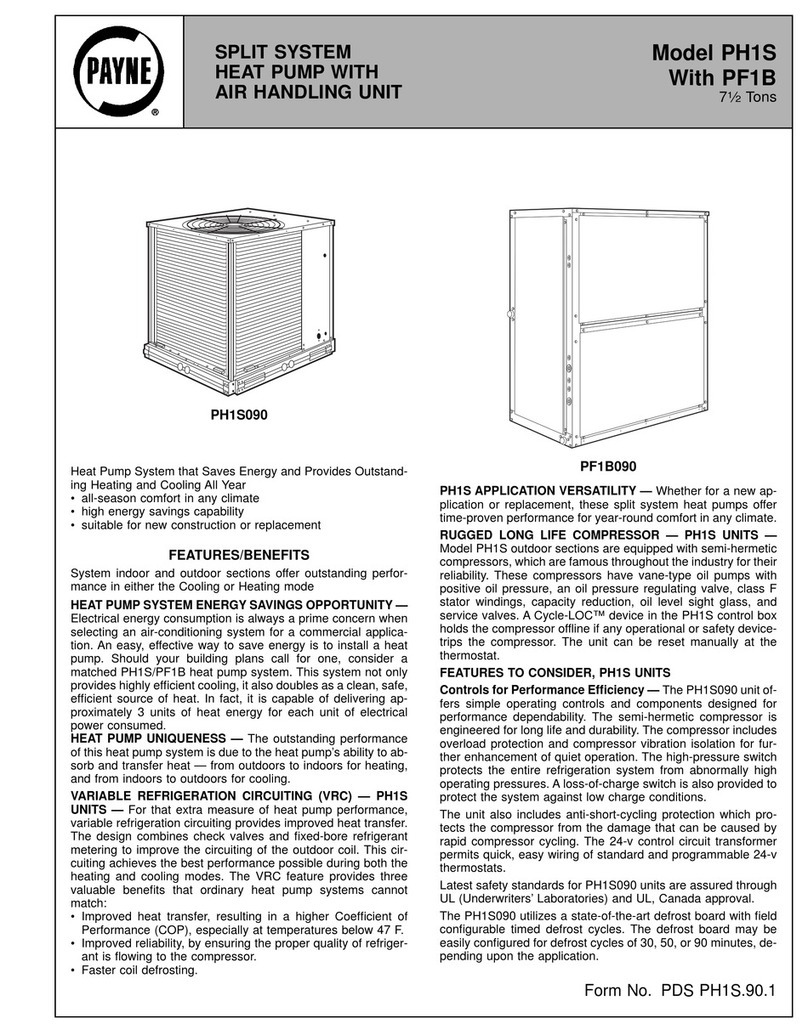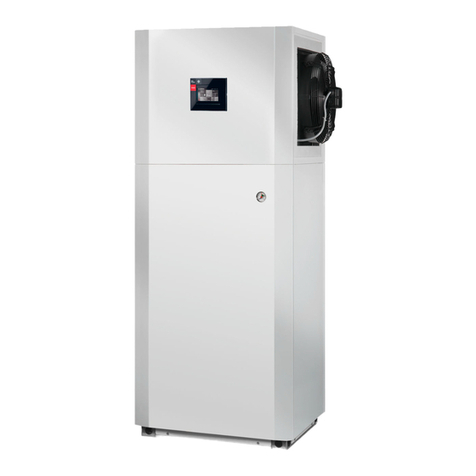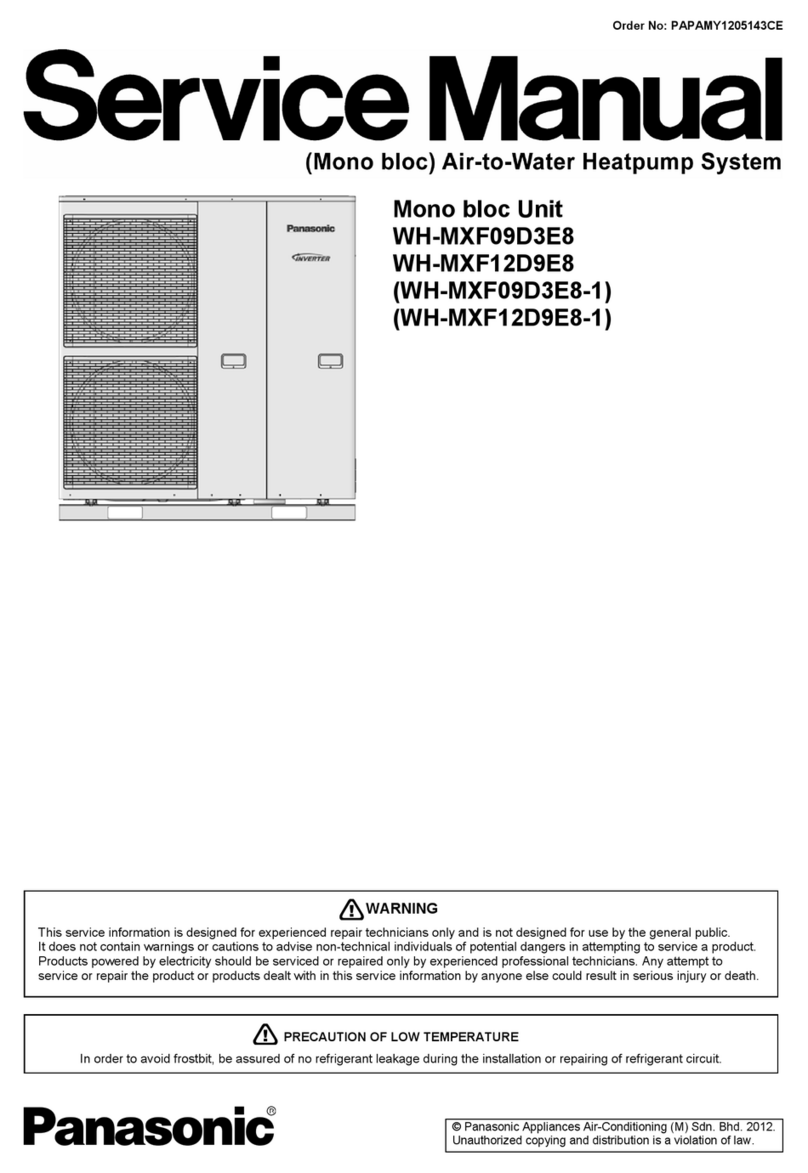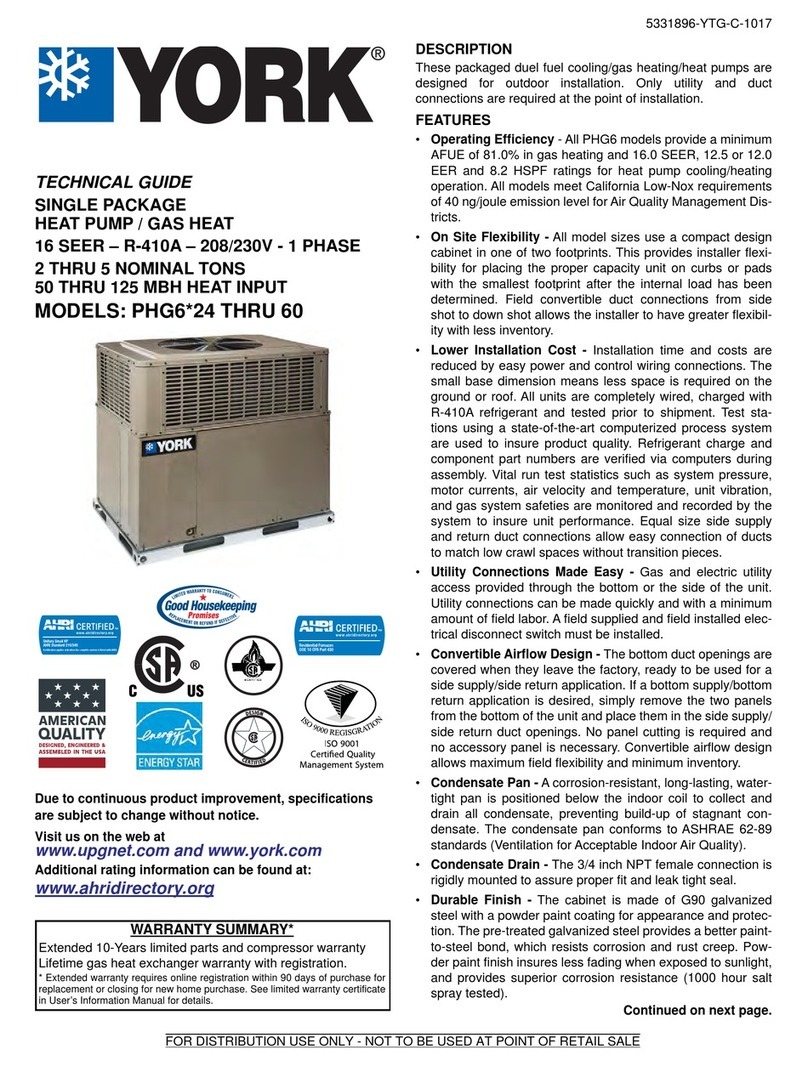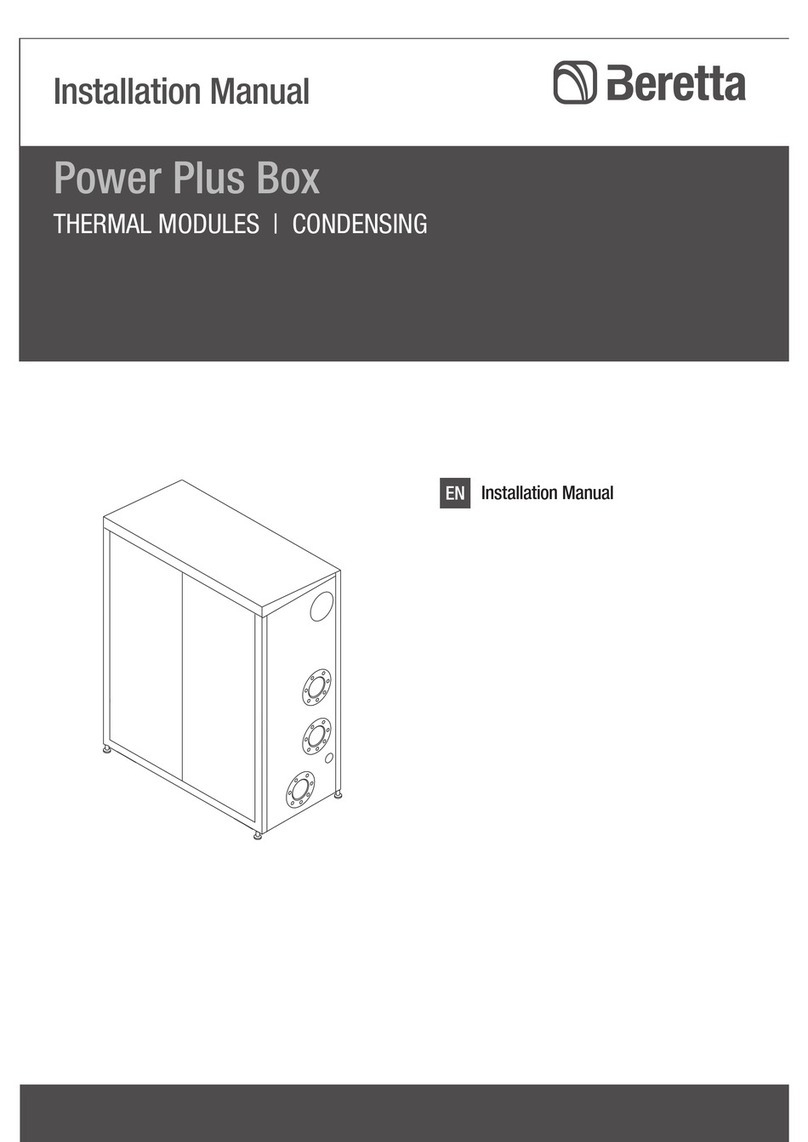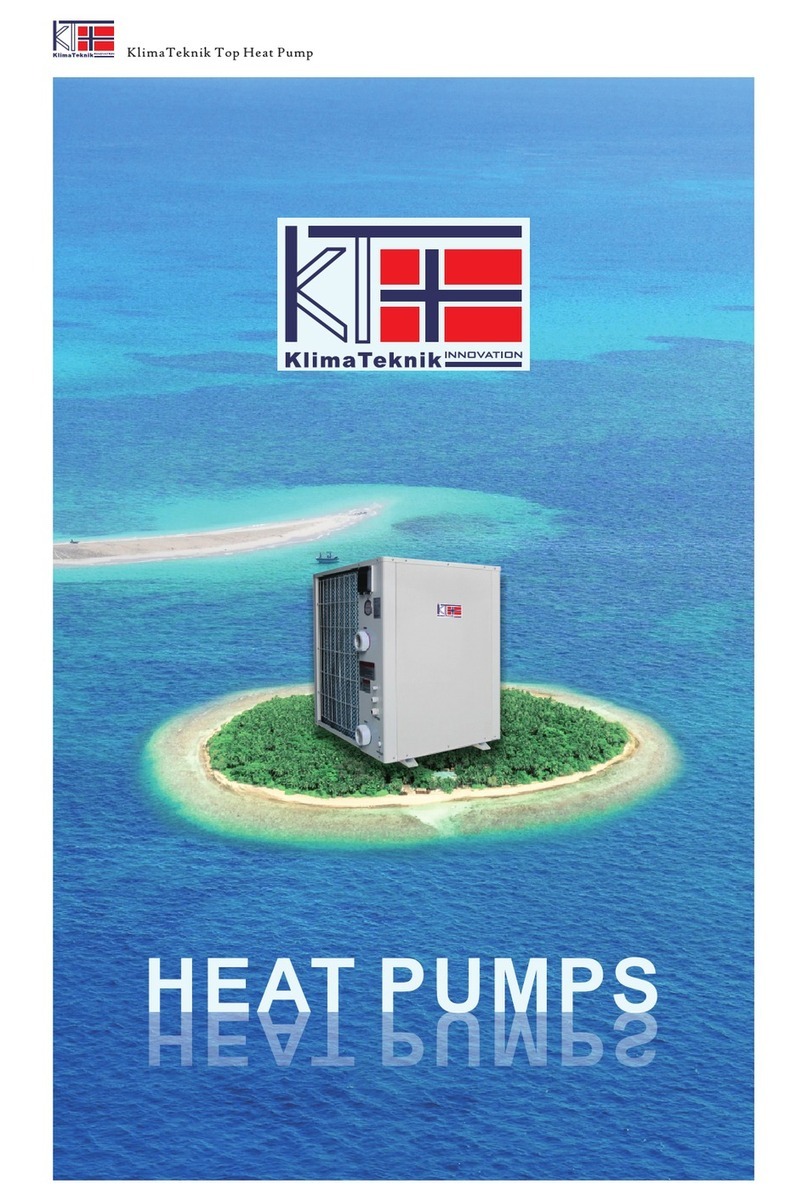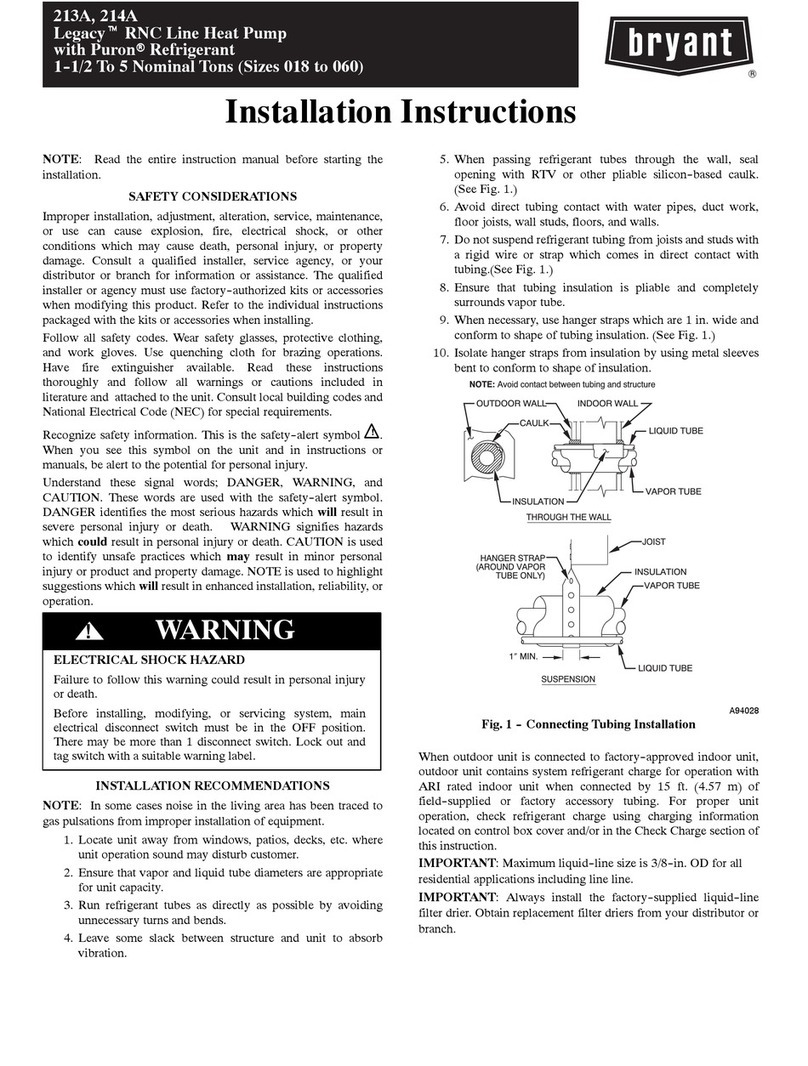Century Comfort-Aire RSG1618S1P User manual

508228-01 Issue 2136 Page 1 of 29
SERVICE MANUAL
RSG16P
(P) 508228-01
*P508228-01*
Table of Contents
Technical Specifications - RSG16P.............................2
Installation ...................................................................6
Refrigeration Piping.....................................................9
Electrical Wiring.........................................................18
Sequence of Operation..............................................21
Start-Up .....................................................................21
Maintenance..............................................................22
Wiring Diagram..........................................................24
Servicing Units Void of Charge..................................25
System Refrigerant....................................................25
Charge Labels ...........................................................28
Start-Up and Performance Checklist.........................29
This is a safety alert symbol and should never be ignored. When you see this symbol on labels or in manuals, be alert to
the potential for personal injury or death.
Electric shock hazard.
Can cause injury or death. Before attempting
to perform any service or maintenance,
turn the electrical power to unit OFF at
disconnect switch(es). Unit may have
multiple power supplies.
WARNING
As with any mechanical equipment, contact with sharp
sheet metal edges can result in personal injury. Take
care while handling this equipment and wear gloves
and protective clothing.
CAUTION
Improper installation, adjustment, alteration, service
or maintenance can cause property damage, personal
injury or loss of life. Installation and service must be
performed by a licensed professional HVAC installer (or
equivalent), service agency or the gas supplier.
WARNING

508228-01Issue 2136
Page 2 of 29
Technical Speci ications - RSG16P
Note:
Weights listed are unit weights with packaging
+ Factory charged for 15 feet of line set. Adjust per installation instructions.
PHYSICAL AND ELECTRICAL DATA
Model Voltage/Hz/Phase
Voltage
Range
Min.
Circuit
Amp.
Max.
Over
Current
Device
(amps)
Compressor
Outdoor Fan
Motor
Shipping
Weight
(lbs.)
Rated
Load
(amps)
Locked
Rotor
(amps)
Rated
Load
(amps)
Rated
HP
RSG1618S1P 208-230/60/1 197-253 11.9 20 9 48 0.7 1/10 134
RSG1624S1P 208-230/60/1 197-253 14.6 25 10.9 59 1 1/6 152
RSG1630S1P 208-230/60/1 197-253 17 25 12.8 68 1 1/6 169
RSG1636S1P 208-230/60/1 197-253 18 30 13.6 79 1 1/6 181
RSG1641S1P 208-230/60/1 197-253 19.3 30 14.7 75 1 1/6 192
RSG1647S1P 208-230/60/1 197-253 21.9 35 16.1 106 1.8 1/3 231
MODEL NUMBER GUIDE
Residential
Condenser
Split
System
Capacity
BTUH x 1000
S = Scroll
Compressor
Series/
Revision
‘Green’ Gas
R-410A
Power
1 = 208/230-1-60
Minimum SEER
R S G 16 24 S 1 P
UNIT DIMENSIONS & SOUND RATINGS
Model
Dimensions (inch) Shipping
Weight
(Lbs.)
Sound
Rating
(dBA)A - Width B - Depth C - Height
RSG1618S1P 24.25 24.25 29 134 73
RSG1624S1P 28.25 28.25 29 154 76
RSG1630S1P 28.25 28.25 37 169 76
RSG1636S1P 28.25 28.25 29 181 76
RSG1641S1P 28.25 28.25 37 227 74
RSG1647S1P 32.25 32.25 43 272 80
Note:
Dimensions listed are unit sizes w/o packaging

508228-01Issue 2136
Page 3 of 29
NOTE:
For the latest ratings, please see
www.marsdelivers.com or www.AHRIdirectory.org
ACCESSORIES
Description Where Used Kit Number
Crankcase Heater All Models 93M04
Hard Start Kit 18 10J42
24, 30, 36, 41, 47 88M91
Low Ambient Kit All Models 34M72
Short Cycle Protector All Models 47J27
Freezestat 3/8 Tubing 93G35
Time Delay Relay All Models 58M81
Loss Of Charge Kit All Models 84M23 (Factory Installed)
Sound Blanket 18, 24, 30, 36, 41 14W00 (Factory Installed)
47 14W01 (Factory Installed)
REFRIGERATION DATA
Model
Refrig. Charge
(oz.) *
Refrigerant Line Size Outdoor Unit Connection Indoor Unit Connection
Suction Liquid Suction Liquid Suction Liquid
RSG1618S1P 73 3/4 3/8 3/4 3/8 3/4 3/8
RSG1624S1P 73 3/4 3/8 3/4 3/8 3/4 3/8
RSG1630S1P 88 3/4 3/8 3/4 3/8 3/4 3/8
RSG1636S1P 113 7/8 3/8 7/8 3/8 7/8 3/8
RSG1641S1P 144 7/8 3/8 7/8 3/8 7/8 3/8
RSG1647S1P 176 7/8 3/8 7/8 3/8 7/8 3/8
*Factory charged for 15 feet of line set
** Adapter shipped with unit

508228-01Issue 2136
Page 4 of 29
FAN BLADE SPECS
RSG16P
Fan Blade
Dia. #of Blades Pitch Part #
-18 18 3 27 98M18
-24 22 3 26 43W37
-30 22 3 26 43W37
-36 22 3 26 15X85
-41 22 3 26 43W37
-47 26 4 22 21W10

508228-01 Issue 2136 Page 5 of 29
COMPRESSOR
HARNESS
CONNECTION
LIQUID LINE SERVICE VALVESUCTION LINE SERVICE VALVE
OUTDOOR COIL
DISCHARGE LINE
HIGH PRESSURE SWITCH
COMPRESSOR
GROUND LUG
CONTACTOR
CONTROL DUAL RUN
CAPACITOR
CONTROL WIRE
LOOP
CUTOUT FOR HIGH
VOLTAGE CONDUIT
NOTE — Plumbing layout and compressor type may vary between model sizes.
CRANKCASE HEATER
THERMOSTAT
CRANKCASE HEATER
THERMAL SWITCH
Figure 1. Typical Parts Arranegment

508228-01Issue 2136
Page 6 of 29
•Locate unit away from overhanging roof lines which
would allow water or ice to drop on, or in front of, coil
or into unit.
When outdoor unit is connected to factory-approved indoor
unit, outdoor unit contains system refrigerant charge for
operation with matching indoor unit when connected by 15
ft. of eld-supplied tubing. For proper unit operation, check
refrigerant charge using charging information located on
control box cover.
Outdoor Section
Zoning ordinances may govern the minimum distance the
condensing unit can be installed from the property line.
Install on a Solid, Level Mounting Pad
The outdoor section is to be installed on a solid foundation.
This foundation should extend a minimum of 2” (inches)
beyond the sides of the outdoor section. To reduce the
possibility of noise transmission, the foundation slab
should NOT be in contact with or be an integral part of the
building foundation. See Figure 2.
If conditions or local codes require the unit be attached to
pad or mounting frame, tie down bolts should be used and
secured to unit base pan.
Installation
These instructions are intended as a general guide and do not supersede local codes in any way. Consult authorities who
have jurisdiction before installation.
NOTE: In some cases, noise in the living area has been
traced to gas pulsations from improper installation of
equipment.
•Locate unit away from windows, patios, decks, etc.
where unit operation sounds may disturb customer.
•Leave some slack between structure and unit to
absorb vibration.
•Place a sound-absorbing material, such as Isomode,
under the unit if it will be installed in a location or
position that will transmit sound or vibration to the
living area or adjacent buildings.
•In heavy snow areas, do not locate the unit where
drifting snow will occur. The unit base should be
elevated above the depth of average snows.
NOTE: Elevation of the unit may be accomplished
by constructing a frame using suitable materials. If a
support frame is constructed, it must not block drain
holes in unit base.
•When installed in areas where low ambient
temperatures exist, locate unit so winter prevailing
winds do not blow directly into outdoor coil.

508228-01 Issue 2136 Page 7 of 29
Discharge Air
Mounting Slab
Ground Level
Building
Structure
Mounting slab must slope slightly away from
building, not to exceed 1/4” per foot.
Figure 2. Slab Mounting
Elevate Unit
Accumulation of water and ice in base pan may cause
equipment damage.
CAUTION
Elevate unit per local climate and code requirements to
provide clearance above estimated snowfall level and
ensure adequate drainage of unit. Use snow stand in areas
where prolonged freezing temperatures are encountered.
If conditions or local codes require the unit be attached to
pad or mounting frame, tie down bolts should be used and
fastened through knockouts provided in unit base pan.
Clearance Requirements
When installing, allow sucient space for airow clearance,
wiring, refrigerant piping, and service. For proper airow,
quiet operation and maximum eciency. Position so water,
snow, or ice from roof or eaves cannot fall directly on unit.
Refer to Table 2 for installation clearances.
Location Minimum Clearance
Service box 30”
Top of unit* 48”
Between units 24”
Against wall 6”
* Maximum sot overhang is 36”.
NOTE: At least one side should be unobstructed by a wall or
other barrier.
Table 2. Clearances
30” around
Control
Box
24”
6”*
Figure 3.
NOTE: See Table 1 for specic minimum clearance guidelines.
DO LOCATE THE UNIT:
•With proper clearances on sides and top of unit
•On a solid, level foundation or pad (unit must be level
to within ± 1/4 in./ft. per compressor manufacturer
specications)
•To minimize refrigerant line lengths
DO NOT LOCATE THE UNIT:
•On brick, concrete blocks or unstable surfaces
•Near clothes dryer exhaust vents where debris
accumulates
•Near sleeping area or near windows
•Under eaves where water, snow or ice can fall directly
on the unit
•With clearance less than 2 ft. from a second unit
•With clearance less than 4 ft. on top of unit
Rooftop Installations
Install unit at a minimum of 6” above surface of the roof
to avoid ice buildup around the unit. Locate the unit
above a load bearing wall or area of the roof that can
adequately support the unit. Consult local codes for rooftop
applications.
If unit cannot be mounted away from prevailing winds, a
wind barrier should be constructed. Due to variation in
installation applications, size and locate barrier according
to the best judgment of the installer.

508228-01Issue 2136
Page 8 of 29
Torque Requirements
When servicing or repairing heating, ventilating, and
air conditioning components, ensure the fasteners are
appropriately tightened. Table 3 lists torque values for
fasteners.
To prevent stripping of the various caps used, the
appropriately sized wrench should be used and tted
snugly over the cap before tightening.
IMPORTANT
When servicing or repairing HVAC components, ensure
the fasteners are appropriately tightened. Table 3 provides
torque values for fasteners.
Only use Allen wrenches of sucient hardness (50Rc
- Rockwell Harness Scale minimum). Fully insert the
wrench into the valve stem recess.
Service valve stems are factory-torqued (from 9 ft-lbs
for small valves, to 25 ft-lbs for large valves) to prevent
refrigerant loss during shipping and handling. Using an
Allen wrench rated at less than 50Rc risks rounding
or breaking o the wrench, or stripping the valve stem
recess.
IMPORTANT
Parts Recommended Torque
Service valve cap 8 ft.-lb. 11 NM
Sheet metal screws 16 in.-lb. 2 NM
Machine screws #10 28 in.-lb. 3 NM
Compressor bolts 90 in.-lb. 10 NM
Gauge port seal cap 8 ft.-lb. 11 NM
Table 3. Torque Requirements
Using Manifold Gauge Set
When checking the system charge, only use a manifold
gauge set that features low loss anti-blow back ttings.
Manifold gauge set used with HFC-410A refrigerant
systems must be capable of handling the higher system
operating pressures.
The gauges should be rated for use with pressures of 0 -
800 psig on the high side and a low side of 30” vacuum to
250 psig with dampened speed to 500 psi. Gauge hoses
must be rated for use at up to 800 psig of pressure with a
4000 psig burst rating.
Operating Service Valves
The liquid and vapor line service valves are used for
removing refrigerant, ushing, leak testing, evacuating,
checking charge and charging. Each valve is equipped
with a service port which has a factory-installed valve stem.
Liquid and Suction Line Service Valves
The liquid line and suction line service valves (see Figure
4) and service ports are used for leak testing, evacuation,
charging, and checking charge.
Each valve is equipped with a service port which has a
factory-installed Schrader valve. A service port cap protects
the Schrader valve from contamination and serves as the
primary leak seal.
To Access the Schrader Port:
1. Remove the service port cap with an adjustable
wrench.
2. Connect gauge to the service port.
3. When testing is completed, replace service port cap.
Tighten nger tight, then an additional 1/6 turn.
To Open Liquid or Suction Line Service Valve:
1. Remove stem cap with an adjustable wrench.
2. Use service wrench with a hex-head extension to back
the stem out counterclockwise as far as it will go. Use a
3/16” hex head extension for liquid line service valves
and a 5/16” extension for suction line service valves.
3. Replace the stem cap. Tighten nger tight, then tighten
an additional 1/6 turn.
To Close Liquid or Suction Line Service Valve:
1. Remove the stem cap with an adjustable wrench.
2. Use a service wrench with a hex-head extension to
turn the stem clockwise to seat the valve. Tighten
rmly.
3. Replace the stem cap. Tighten nger tight, then tighten
an additional 1/6 turn.
Suction Line (Ball Type) Service Valve
Suction line (ball type) service valves function the same
way as the other valves; the dierence is in the construction
(see Figure 5).
The ball valve is equipped with a service port with a factory-
installed Schrader valve. A service port cap protects the
Schrader valve from contamination and serves as the
primary seal.

508228-01 Issue 2136 Page 9 of 29
Refrigeration Piping
•Use only refrigerant grade copper tubes.
•Split systems may be installed with up to 50 feet of
line set (no more than 20 feet vertical) without special
consideration (see long line set guidelines).
•Ensure that vapor and liquid tube diameters are
appropriate to capacity of unit.
•Run refrigerant tubes as directly as possible by
avoiding unnecessary turns and bends.
•When passing refrigerant tubes through the wall, seal
opening with RTV or other silicon-based caulk.
•Avoid direct tubing contact with water pipes, duct work,
oor joists, wall studs, oors, walls, and any structure.
•Do not suspend refrigerant tubing from joists and
studs with a rigid wire or strap that comes in direct
contact with tubing.
•Ensure that tubing insulation is pliable and completely
surrounds vapor tube.
It is important that no tubing be cut or seals broken until you
are ready to actually make connections to the evaporator
and to the condenser section. DO NOT remove rubber
plugs or copper caps from the tube ends until ready to
make connections at evaporator and condenser. Under no
circumstances leave the lines open to the atmosphere for
any period of time, if so unit requires additional evacuation
to remove moisture.
Model
RSG16P
Liquid Line Suction Line
18 3/8 3/4
24 3/8 3/4
30 3/8 3/4
36 3/8 7/8
41 3/8 7/8
47 3/8 7/8
* Fittings should be supplied by the installer.
Table 4.
Be extra careful with sharp bends. Tubing can “kink” very
easily, and if this occurs, the entire tube length will have
to be replaced. Extra care at this time will eliminate future
service problems.
Figure 4.
Figure 5.

508228-01Issue 2136
Page 10 of 29
ANCHORED HEAVY NYLON
WIRE TIE OR AUTOMOTIVE
MUFFLER‐TYPE HANGER
STRAP LIQUID LINE TO
VAPOR LINE
WALL
STUD
LIQUID LINE
NON-CORROSIVE
METAL SLEEVE
VAPOR LINE - WRAPPED
IN ARMAFLEX
AUTOMOTIVE
MUFFLER‐TYPE HANGER
REFRIGERANT LINE SET — TRANSITION
FROM VERTICAL TO HORIZONTAL
Line Set Isolation — The following illustrations are
examples of proper refrigerant line set isolation:
STRAPPING
MATERIAL (AROUND
VAPOR LINE ONLY)
TAPE OR
WIRE TIE
WIRE TIE (AROUND
VAPOR LINE ONLY)
FLOOR JOIST OR
ROOF RAFTER
TAPE OR
WIRE TIE
To hang line set from joist or rafter, use either metal strapping material
or anchored heavy nylon wire ties.
8 FEET (2.43 METERS)
STRAP THE VAPOR LINE TO THE JOIST
OR RAFTER AT 8 FEET (2.43 METERS)
INTERVALS THEN STRAP THE LIQUID
LINE TO THE VAPOR LINE.
FLOOR JOIST OR
ROOF RAFTER
REFRIGERANT LINE SET — INSTALLING
HORIZONTAL RUNS
NOTE — Similar installation practices should be used if line set is
to be installed on exterior of outside wall.
PVC
PIPE
FIBERGLASS
INSULATION
CAULK
OUTSIDE
WALL
VAPOR LINE WRAPPED
WITH ARMAFLEX
LIQUID
LINE
OUTSIDE WALL LIQUID LINE
VAPOR LINE
WOOD BLOCK
BETWEEN STUDS
STRAP
WOOD BLOCK
STRAP
SLEEVE
WIRE TIE
WIRE TIE
WIRE TIE
INSIDE WALL
REFRIGERANT LINE SET — INSTALLING
VERTICAL RUNS (NEW CONSTRUCTION SHOWN)
INSTALLATION
LINE SET
NOTE — Insulate liquid line when it is routed through areas where the
surrounding ambient temperature could become higher than the
temperature of the liquid line or when pressure drop is equal to or greater
than 20 psig.
NON-CORROSIVE
METAL SLEEVE
IMPORTANT —Refrigerant lines must not contact structure.
NON-CORROSIVE
METAL SLEEVE
8 FEET (2.43 METERS)
IMPORTANT —Refrigerant lines must not contact wall

508228-01 Issue 2136 Page 11 of 29
It is recommended that vertical suction risers not be up-
sized. Proper oil return to the compressor should be
maintained with suction gas velocity.
Filter Drier
The lter drier is very important for proper system operation
and reliability. If the drier is shipped loose, it must be
installed by the installer in the eld. Unit warranty will be
void, if the drier is not installed.
Installation of Line Sets
DO NOT fasten liquid or suction lines in direct contact with
the oor or ceiling joist. Use an insulated or suspension
type of hanger. Keep both lines separate, and always
insulate the suction line. Liquid line runs (30 feet or more)
in an attic will require insulation. Route refrigeration line
sets to minimize length.
DO NOT let refrigerant lines come in direct contact with
foundation. When running refrigerant lines through the
foundation or wall, openings should allow for a sound
and vibration absorbing material to be placed or installed
between tubing and foundation. Any gap between
foundation or wall and refrigerant lines should be lled with
a vibration damping material.
If ANY refrigerant tubing is required to be buried by state
or local codes, provide a 6 inch vertical rise at service
valve.
CAUTION
Installation into an Existing R-22 System
If the unit will be installed in an existing system that uses
an indoor unit or line sets charged with R-22 refrigerant,
installer must perform the following procedures to convert
the system to an R-410A system.
Remove Existing Expansion Valve
1. On fully cased coils, remove the coil access and
plumbing panels.
2. Remove any shipping clamps from the liquid line and
distributor assembly.
3. Disconnect the equalizer line from the check expansion
valve equalizer line tting on the vapor line.
4. Remove the vapor line sensing bulb.
5. Disconnect the liquid line from the check expansion
valve at the liquid line assembly.
6. Disconnect the check expansion valve from the liquid
line orice housing. Take care not to twist or damage
distributor tubes during this process.
7. Remove and discard check expansion valve and the
two Teon® rings (see Figure 6).
8. Use a eld-provided tting to temporarily reconnect the
liquid line to the indoor unit’s liquid line orice housing.
SENSING
LINE
TWO-PIECE PATCH PLATE
(UNCASED COIL ONLY)
VAPOR
LINE
DISTRIBUTOR
ASSEMBLY
DISTRIBUTOR
TUBES
LIQUID
LINE
MALE EQUALIZER
LINE FITTING
EQUALIZER
LINE
EXPANSION
VALV E
TEFLON®
RING
STUB END
TEFLON®
RING
SENSING BULB
LIQUID LINE
ORIFICE
HOUSING
LIQUID LINE
ASSEMBLY WITH
BRASS NUT
Figure 6. Remove Existing Expansion Valve
(uncased coil shown)
Flushing Line Sets
If the unit will be installed in an existing system that uses
an indoor unit or line sets charged with R-22 refrigerant,
installer must perform the following ushing procedure.
NOTE: Existing system components (including line set
and indoor coil) must be an AHRI match with the unit in
order to fulll unit warranty requirements.
Refrigerant must be reclaimed in accordance with
national and local codes.
WARNING
Do NOT attempt to ush and re-use existing line sets
or indoor coil when the system contains contaminants
(i.e., compressor burn out).
CAUTION
“Clean refrigerant” is any refrigerant in a system that
has not had compressor burnout. If the system has
experienced burnout, it is recommended that the
existing line set and indoor coil be replaced.
NOTE
In lieu of R-410A, an industry-standard ushing agent
may also be used.
NOTE

508228-01Issue 2136
Page 12 of 29
LOW
HIGH
EXISTING
INDOOR
UNIT
GAUGE
MANIFOLD
CYLINDER CONTAINING
CLEAN R-410A TO BE
USED FOR FLUSHING
(Positioned to deliver liquid
refrigerant)
LIQUID LINE SERVICE
VALVE
INLET
DISCHARGE
TANK
RETURN
CLOSED
OPENED
RECOVER
Y
CYLINDER
RECOVERY MACHINE
NEW
OUTDOOR
UNIT
VAPOR LINE
SERVICE VALVE
VAPOR
LIQUID
1
A
B
C
D
ACylinder with clean R-410A (positioned to deliver liquid refrigerant) to the
vapor service valve.
BRefrigerant gauge set (low side) to the liquid line valve.
CRefrigerant gauge set center port to inlet on the recovery machine with
an empty recovery tank connected to the gauge set.
DConnect recovery tank to recovery machine per machine instructions.
Figure 7.
1. Connect gauges and equipment as shown in Figure 7.
2. Set the recovery machine for liquid recovery and start
the recovery machine. Open the gauge set valves to
allow the recovery machine to pull a vacuum on the
existing system line set and indoor unit coil.
3. Position the cylinder of clean R-410A for delivery of
liquid refrigerant and open its valve to allow liquid
refrigerant to ow into the system through the vapor
line valve. Allow the refrigerant to pass from the
cylinder and through the line set and the indoor unit
coil before it enters the recovery machine.
4. After all of the liquid refrigerant has been recovered,
switch the recovery machine to vapor recovery so
that all of the R-410A vapor is recovered. Allow the
recovery machine to pull the system down to 0.
5. Close the valve on the inverted R-410A drum and the
gauge set valves. Pump the remaining refrigerant out
of the recovery machine and turn the machine o.

508228-01 Issue 2136 Page 13 of 29
Refrigerant Piping - Install Indoor Expansion Valve
This outdoor unit is designed for use in systems that include an expansion valve metering device (purchased separately) at
the indoor coil. See the Product Specications for approved expansion valve kit match-ups and application information. The
check expansion valve unit can be installed internal or external to the indoor coil. In applications where an uncased coil is
being installed in a eld-provided plenum, install the check/expansion valve in a manner that will provide access for future
eld service of the expansion valve. Refer to below illustration for reference during installation of expansion valve unit.
1 -Attach the vapor line sensing bulb in the proper
orientation as illustrated to the right using the clamp and
screws provided.
NOTE - Though it is preferred to have the sensing bulb
installed on a horizontal run of the vapor line, installation
on a vertical run of piping is acceptable if necessary.
NOTE - Confirm proper thermal contact between vapor
line and check/expansion bulb before insulating the
sensing bulb once installed.
2 -Connect the equalizer line from the check expansion
valve to the equalizer vapor port on the vapor line. Finger
tighten the flare nut plus 1/8 turn (7 ft-lbs) as illustrated
below.
TWO PIECE
PATCH PLATE
(UNCASED
COIL ONLY)
VAPOR
LINE
LIQUID LINE
ORIFICE
HOUSING
DISTRIBUTOR
TUBES
LIQUID LINE
MALE EQUALIZER LINE
FITTING (SEE
EQUALIZER LINE
INSTALLATION FOR
FURTHER DETAILS)
SENSING
LINE
EQUALIZER
LINE
EXPANSION
VALVE
TEFLON®
RING
(Uncased Coil Shown)
Sensing bulb insulation is required if
mounted external to the coil casing. sensing
bulb installation for bulb positioning.
STUB
END
TEFLON®
RING
LIQUID LINE
ASSEMBLY WITH
BRASS NUT
DISTRIBUTOR
ASSEMBLY
3 -Install one of the provided Teflon®rings around the
stubbed end of the check expansion valve and lightly
lubricate the connector threads and expose surface of
the Teflon®ring with refrigerant oil.
4 -Attach the stubbed end of the check expansion valve to
the liquid line orifice housing. Finger tighten and use an
appropriately sized wrench to turn an additional 1/2 turn
clockwise as illustrated in the figure above, or tighten to
20 ft-lb.
5 -Place the remaining Te flon®washer around the other
end of the check expansion valve. Lightly lubricate
connector threads and expose surface of the Teflon®
ring with refrigerant oil.
6 -Attach the liquid line assembly to the check expansion
valve. Finger tighten and use an appropriately sized
wrench to turn an additional 1/2 turn clockwise as
illustrated in the figure above or tighten to 20 ft-lb.
ON 7/8” AND LARGER LINES,
MOUNT SENSING BULB AT
EITHER THE 4 OR 8 O'CLOCK
POSITION.
12
ON LINES SMALLER THAN
7/8”, MOUNT SENSING
BULB AT EITHER THE 3 OR
9 O'CLOCK POSITION.
12
BULB
VAPOR LINE
VAPOR LINE
NOTE - NEVER MOUNT THE SENSING BULB ON
BOTTOM OF LINE.
BULB
BULB
BULB
VAPOR LINE
FLARE NUT
COPPER FLARE
SEAL BONNET
MALE BRASS EQUALIZER
LINE FITTING
FLARE SEAL CAP
OR
1
2
3
4
5
6
7
8
9
10
11 12
1/2 Turn
SENSING BULB INSTALLATION
EQUALIZER LINE INSTALLATION
1
2
3
4
5
6
7
8
9
10
11 12
1/8 Turn
1 -Remove and discard either the flare seal cap or flare nut
with copper flare seal bonnet from the equalizer line port
on the vapor line as illustrated in the figure below.
2 -Remove the field-provided
sembly.
INDOOR EXPANSION VALVE INSTALLATION

508228-01Issue 2136
Page 14 of 29
Before brazing, ensure the system is fully
recovered of all refrigerant. Application of a
brazing torch to a pressurized system may
result in ignition of the refrigerant and oil
mixture. Check the high and low pressures
before applying heat.
WARNING
Brazing alloys and ux contain materials which are
hazardous to your health.
Avoid breathing vapors or fumes from brazing
operations. Perform operations only in well-ventilated
areas.
Wear gloves and protective goggles or face shield to
protect against burns.
Wash hands with soap and water after handling brazing
alloys and ux.
WARNING
Use a manifold gauge set designed for use on R-410A
refrigerant systems.
NOTE
ATTACH THE MANIFOLD GAUGE SET FOR BRAZING LIQUID AND VAPOR LINE SERVICE VALVES
OUTDOOR
UNIT
LIQUID LINE
VAPOR LINE
LIQUID LINE SERVICE
VALV E
VAPOR LINE
SERVICE
VALV E
ATTACH
GAUGES
INDOOR
UNIT
VAPOR SERVICE PORT MUST BE OPEN
TO ALLOW EXIT POINT FOR NITROGEN
A -Connect gauge set low pressure side to
liquid line service valve (service port).
B -Connect gauge set center port to bottle of
nitrogen with regulator.
C -Remove core from valve in vapor line
service port to allow nitrogen to escape.
NITROGEN
HIGHLOW USE REGULATOR TO FLOW
NITROGEN AT 1 TO 2 PSIG.
B
A
C
WHEN BRAZING LINE SET TO
SERVICE VALVES, POINT FLAME
AWAY FROM SERVICE VALVE.
Flow regulated nitrogen (at 1 to 2 psig) through the low-side refrigeration gauge set into the liquid line service port valve, and out of the
vapor line service port valve.
CUT AND DEBUR CAP AND CORE REMOVAL
Cut ends of the refrigerant lines square (free from nicks or dents)
and debur the ends. The pipe must remain round. Do not crimp end
of the line.
Remove service cap and core from
both the vapor and liquid line service
ports.
12
LIQUID LINE SERVICE
VALV E
SERVICE
PORT
CORE
SERVICE PORT
CAP
SERVICE
PORT
CORE
SERVICE
PORT CAP
CUT AND DEBUR
LINE SET SIZE MATCHES
SERVICE VALVE CONNECTION
DO NOT CRIMP SERVICE VALVE
CONNECTOR WHEN PIPE IS
SMALLER THAN CONNECTION
3
VAPOR LINE SERVICE
VALV E
COPPER TUBE
STUB
REFRIGERANT LINE
REDUCER
SERVICE VALVE
CONNECTION
LINE SET SIZE IS SMALLER
THAN CONNECTION
Refrigerant Piping - Brazing Procedures

508228-01 Issue 2136 Page 15 of 29
WHEN BRAZING LINE SET TO
SERVICE VALVES, POINT FLAME
AWAY FROM SERVICE VALVE.
LIQUID LINE SERVICE VALVE
LIQUID LINE
BRAZE LINE SET
Wrap both service valves with water-saturated cloths as illustrated here and as mentioned in step 4, before brazing to line set.
Cloths must remain water-saturated throughout the brazing and cool-down process.
WATER-SATURATED
CLOTH
IMPORTANT — Allow braze joint to cool. Apply
additional water-saturated cloths to help cool brazed
joint. Do not remove water-saturated cloths until
piping has cooled. Temperatures above 250ºF will
damage valve seals.
6
VAPOR LINE
WATER-SATURATED
CLOTH
VAPOR LINE
SERVICE VALVE
After all connections have been brazed, disconnect manifold gauge set from service ports. Apply additional water-saturated cloths to both
services valves to cool piping. Once piping is cool, remove all water-saturated cloths.
WHEN BRAZING LINE SET TO
SERVICE VALVES, POINT FLAME
AWAY FROM SERVICE VALVE.
PREPARATION FOR NEXT STEP
7
WRAP SERVICE VALVES
To help protect service valve seals during brazing, wrap water-saturated cloths around service valve bodies and copper tube stubs. Use
additional water-saturated cloths underneath the valve body to protect the base paint.
4
FLOW NITROGEN
Flow regulated nitrogen (at 1 to 2 psig) through the refrigeration gauge set into the valve stem port connection on the liquid service valve and
out of the vapor valve stem port. See steps 3A, 3B and 3C on manifold gauge set connections.
5
WARNING
FIRE, PERSONAL INJURY, OR PROPERTY DAMAGE
may result if you do not wrap a water-saturated cloth around
both liquid and suction line service valve bodies and copper
tube stub while brazing the line set! The braze, when
complete, must be quenched with water to absorb any
residual heat.
Do not open service valves until refrigerant lines and
indoor coil have been leak-tested and evacuated. Refer
to Leak Test and Evacuation section of this manual.
WARNING
While protecting the
service valve seals with
water-saturated cloths,
ensure that water does
NOT enter the system.

508228-01Issue 2136
Page 16 of 29
Leak Test and Evacuation
TO VAPOR
SERVICE VALVE
HFC-410A
MANIFOLD GAUGE SET
OUTDOOR UNIT
HIGH
LOW
1
2
A
B
NITROGEN
NOTE - Position
canister to deliver
liquid refrigerant.
A -With both manifold valves closed, connect the cylinder of HFC-410A refrigerant to the center port of the
manifold gauge set. Open the valve on the HFC-410A cylinder (vapor only).
B - Open the high pressure side of the manifold to allow HFC-410A into the line set and indoor unit. Weigh in
a trace amount of HFC-410A.[A trace amount is a maximum of two ounces (57 g) refrigerant or three
pounds (31 kPa) pressure.] Close the valve on the HFC-410A cylinder and the valve on the high
pressure side of the manifold gauge set. Disconnect the HFC-410A cylinder.
C - Connect a cylinder of nitrogen with a pressure regulating valve to the center port of the manifold gauge
set.
D - Adjust nitrogen pressure to 150 psig (1034 kPa). Open the valve on the high side of the manifold gauge set
in order to pressurize the line set and the indoor unit.
E - After a few minutes, open one of the service valve ports and verify that the refrigerant added to the
system earlier is measurable with a leak detector.
F -
After the line set has been connected to the indoor and outdoor units, check the line set connections and
indoor unit for leaks. Use the following procedure to test for leaks:
A -Connect the high pressure hose of an HFC-410A manifold gauge set to the vapor valve service port.
NOTE - Normally, the high pressure hose is connected to the liquid line port. However, connecting it
to the vapor port better protects the manifold gauge set from high pressure damage.
B - With both manifold valves closed, connect the cylinder of HFC-410A refrigerant to the center port of
the manifold gauge set.
CONNECT GAUGE SET
TEST FOR LEAKS
NOTE - Later in the procedure, the HFC-410A container will be replaced by the nitrogen container.
After leak testing, disconnect gauges from service ports.
NOTE - Service valve cores remain removed for the following evacuation procedure.
LEAK TEST

508228-01 Issue 2136 Page 17 of 29
A - Open both manifold valves and start the vacuum pump.
B -
NOTE - During the early stages of evacuation, it is desirable to close the manifold gauge valve at least once. A rapid rise in pressure
indicates a relatively large leak. If this occurs, repeat the leak testing procedure.
NOTE - The term absolute pressure means the total actual pressure above absolute zero within a given volume or system. Absolute
pressure in a vacuum is equal to atmospheric pressure minus vacuum pressure.
C - When the absolute pressure reaches 23,000 microns (29.01 inches of
mercury), perform the following:
Close manifold gauge valves.
Close valve on vacuum pump.
Turn off vacuum pump.
Disconnect manifold gauge center port hose from vacuum pump.
Attach manifold center port hose to a nitrogen cylinder with pressure
regulator set to 150 psig (1034 kPa) and purge the hose.
Open manifold gauge valves to break the vacuum in the line set and indoor
unit.
Close manifold gauge valves.
D - Shut off the nitrogen cylinder and remove the manifold gauge hose from the cylinder. Open the manifold gauge valves to release the
nitrogen from the line set and indoor unit.
E - Reconnect the manifold gauge to the vacuum pump, turn the pump on, and continue to evacuate the line set and indoor unit until the
absolute pressure does not rise above 500 microns (29.9 inches of mercury) within a 20-minute period after shutting off the vacuum pump
and closing the manifold gauge valves.
F - When the absolute pressure requirement above has been met, disconnect the manifold hose from the vacuum pump and connect it to a
cylinder of HFC-410A positioned to deliver liquid refrigerant. Open the manifold gauge valve 1 to 2 psig in order to release the vacuum in the
line set and indoor unit.
G - Perform the following:
Close manifold gauge valves.
Shut off HFC-410A cylinder.
Reinstall service valve cores by removing manifold hose from service valve. Quickly install cores with core
tool while maintaining a positive system pressure.
Replace stem caps and finger tighten them, then tighten an additional one-sixth (1/6) of a turn as illustrated.
OUTDOOR
UNIT
TO VAPOR
SERVICE VALVE
TO LIQUID LINE
SERVICE VALVE
MICRON
GAUGE
VACUUM PUMP
1/4 SAE TEE WITH SWIVEL
COUPLER
500
MANIFOLD
GAUGE SET
HFC-410A
RECOMMEND
MINIMUM 3/8” HOSE
A - Connect low side of manifold gauge set with
1/4 SAE in-line tee to vapor line service valve
B - Connect high side of manifold gauge set to
liquid line service valve
C - Connect available micron gauge connector
on the 1/4 SAE in-line tee.
D - Connect the vacuum pump (with vacuum
gauge) to the center port of the manifold
gauge set. The center port line will be used
later for both the HFC-410A and nitrogen
containers.
HIGH
LOW
1
2
3
4
5
6
7
8
9
10
11 12
1/6 TURN
NITROGEN
3CONNECT GAUGE SET
A
B
C
D
4EVACUATE THE SYSTEM
NOTE - Remove cores from service valves (if not already done).
Possible equipment damage.
Avoid deep vacuum operation. Do not use
compressors to evacuate a system.
Extremely low vacuum can cause internal
arcing and compressor failure. Damage
caused by deep vacuum operation will
void warranty.
WARNING !
EVACUATION
H - Open suction service valve first before liquid valve to release the unit charge into the system. Replace valve
caps and tighten (8 ft. lb.). Caps are the primary seal.
Evacuate the line set and indoor unit until a slight vacuum is indicated on the micron gauge (approximately 23,000 microns or
29.01 inches of mercury).
NOTE - Position
canister to deliver
liquid refrigerant.

508228-01Issue 2136
Page 18 of 29
Electrical Wiring
All eld wiring must be done in accordance with the National
Electrical Code (NEC) recommendations, Canadian
Electrical Code (CEC) and CSA Standards, or local codes,
where applicable.
Electrical Shock Hazard!
Turn OFF electric power before connecting
unit, performing any maintenance or
removing panels or doors. More than one
disconnect may be required to turn o all
power.
FAILURE TO DO SO COULD RESULT IN
BODILY INJURY OR DEATH.
WARNING
Unit must be grounded in accordance with national and
local codes. Failure to ground unit properly can result in
personal injury or death.
WARNING
Line voltage is present at all components when unit is
not in operation on units with single pole contactors.
Disconnect all remote electric power supplies before
opening access panel. Unit may have multiple power
supplies. Failure to disconnect all power supplies could
result in personal injury or death.
WARNING
Refer to the furnace or blower coil Installation Instructions
for additional wiring application diagrams and refer to unit
rating plate for minimum circuit ampacity and maximum
overcurrent protection size.
1. Install line voltage power supply to unit from a properly
sized disconnect switch. Any excess high voltage eld
wiring should be trimmed or secured away from the
low voltage eld wiring.
2. High voltage power connections to 3-phase models
is made to “Pig Tail” leads with eld supplied splice
connectors.
3. Ground unit at unit disconnect switch or to an earth
ground. To facilitate conduit, a hole is in the bottom
of the control box. Connect conduit to the control box
using a proper conduit tting. Units are approved for
use only with copper conductors. 24V Class II circuit
connections are made in the low voltage junction box.
A complete unit wiring diagram is located inside the
unit control box cover.
4. Install room thermostat according to thermostat
installation instruction and on an inside wall that is
not subject to drafts, direct sunshine, or other heat
sources.
5. Install low voltage wiring from outdoor to indoor unit
and from thermostat to indoor unit (see Figure 8).
6. Do not bundle any excess 24V control wire inside
control box. Run control wire through installed wire tie
and tighten wire tie to provide low voltage strain relief
and to maintain separation of eld-installed low and
high voltage circuits.
1Refer to thermostat installation instructions
2“L” is used for any accessories (e.g. diagnostic /
warning / alarm), used to activate thermostat
warning light
R
RR
C
CC
G
GIndoor Blower Only
Thermostat Indoor Unit Outdoor Unit
L L
Y1 Compressor Y1
1
1
L
2
W
W1 Heat
1
Figure 8. Thermostat Designations -
Non-Communicating

508228-01 Issue 2136 Page 19 of 29
HIGH PRESSURE SWITCH
(S4) — LIQUID LINE
CRANKCASE THERMOSTAT (S40)
CRANKCASE HEATER (HR1)
Figure 9. Typical Factory Wiring Diagram (Copeland Compressor)

508228-01 Issue 2136 Page 20 of 29
CRANKCASE HEATER (HR1)
HIGH PRESSURE SWITCH
(S4) — LIQUID LINE
CRANKCASE THERMOSTAT (S40)
THERMAL PROTECTION
SWITCH (S5 OR S173)
Figure 11. Typical Factory Wiring Diagram (Interlink Compressor)
This manual suits for next models
5
Table of contents
Popular Heat Pump manuals by other brands

nilan
nilan Compact P user manual
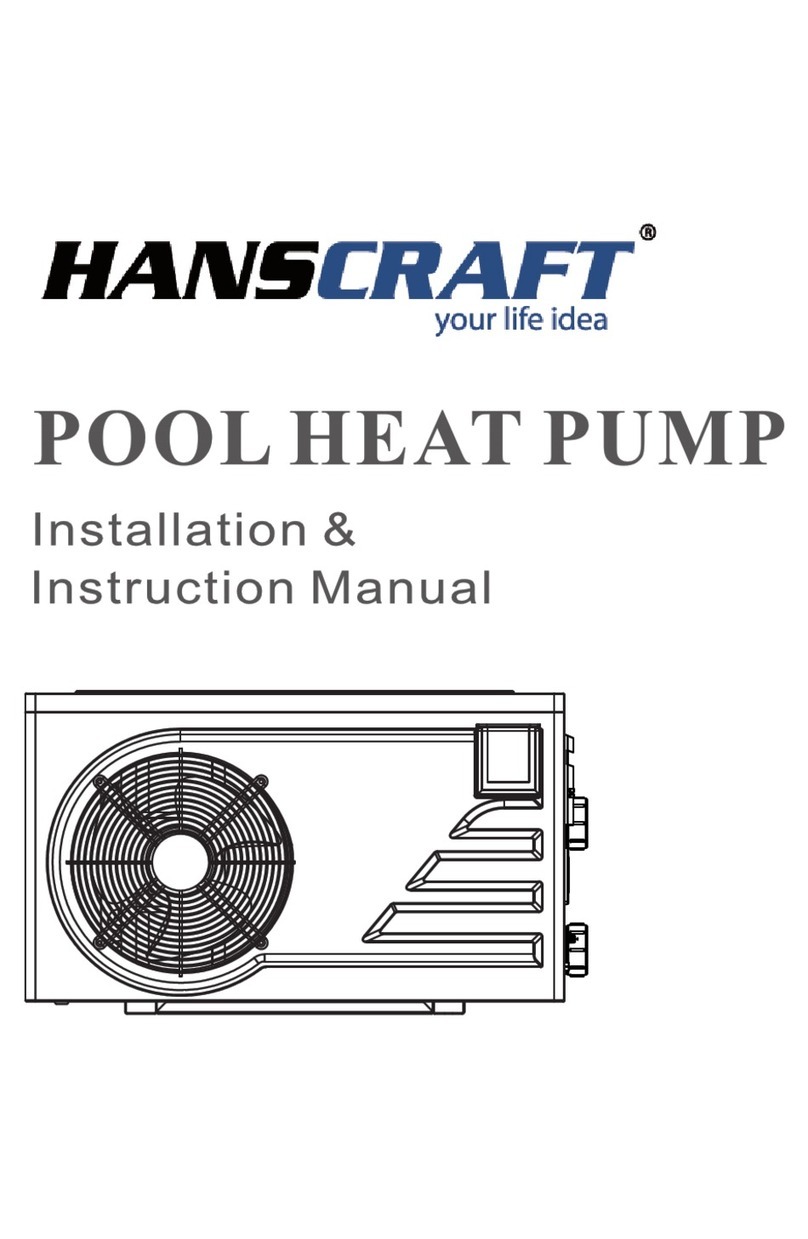
HANSCRAFT
HANSCRAFT Evolution 25 Installation instructions manual

STIEBEL ELTRON
STIEBEL ELTRON WWK 300 electronic SOL Operation and installation manual

Riello
Riello NexSirius Series Instructions for the installer and the technical service centre

Ideal Heating
Ideal Heating ECOMOD AHP60 14 kW Installation and servicing
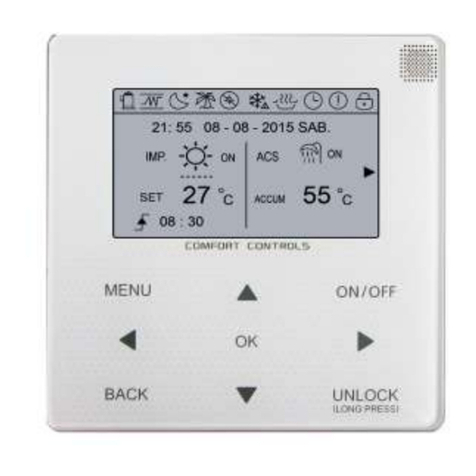
Ferroli
Ferroli RXA-I PLUS Series user manual


